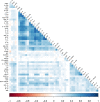Inflammatory proteomics profiling for prediction of incident atrial fibrillation
- PMID: 36801832
- PMCID: PMC10314054
- DOI: 10.1136/heartjnl-2022-321959
Inflammatory proteomics profiling for prediction of incident atrial fibrillation
Abstract
Objective: Atrial fibrillation (AF) has emerged as a common condition in older adults. Cardiovascular risk factors only explain about 50% of AF cases. Inflammatory biomarkers may help close this gap as inflammation can alter atrial electrophysiology and structure. This study aimed to determine a cytokine biomarker profile for this condition in the community using a proteomics approach.
Methods: This study uses cytokine proteomics in participants of the Finnish population-based FINRISK cohort studies 1997/2002. Risk models for 46 cytokines were developed to predict incident AF using Cox regressions. Furthermore, the association of participants' C reactive protein (CRP) and N-terminal pro B-type natriuretic peptide (NT-proBNP) concentrations with incident AF was examined.
Results: In 10 744 participants (mean age of 50.9 years, 51.3% women), 1246 cases of incident AF were observed (40.5% women). The main analyses, adjusted for participants' sex and age, suggested that higher concentrations of macrophage inflammatory protein-1β (HR=1.11; 95% CI 1.04, 1.17), hepatocyte growth factor (HR=1.12; 95% CI 1.05, 1.19), CRP (HR=1.17; 95% CI 1.10, 1.24) and NT-proBNP (HR=1.58; 95% CI 1.45, 1.71) were associated with increased risk of incident AF. In further clinical variable-adjusted models, only NT-proBNP remained statistically significant.
Conclusion: Our study confirmed NT-proBNP as a strong predictor for AF. Observed associations of circulating inflammatory cytokines were primarily explained by clinical risk factors and did not improve risk prediction. The potential mechanistic role of inflammatory cytokines measured in a proteomics approach remains to be further elucidated.
Keywords: atrial fibrillation; biomarkers; epidemiology; inflammation.
© Author(s) (or their employer(s)) 2023. Re-use permitted under CC BY-NC. No commercial re-use. See rights and permissions. Published by BMJ.
Conflict of interest statement
Competing interests: RBS received consulting fees and speaker honoraria from BMS/Pfizer. SV reports personal fees from Sanofi and a grant from Bayer Ltd outside the submitted work.
Figures




Similar articles
-
Exploring the incremental utility of circulating biomarkers for robust risk prediction of incident atrial fibrillation in European cohorts using regressions and modern machine learning methods.Europace. 2023 Mar 30;25(3):812-819. doi: 10.1093/europace/euac260. Europace. 2023. PMID: 36610061 Free PMC article.
-
NT-proBNP is a powerful predictor for incident atrial fibrillation - Validation of a multimarker approach.Int J Cardiol. 2016 Nov 15;223:74-81. doi: 10.1016/j.ijcard.2016.08.001. Epub 2016 Aug 4. Int J Cardiol. 2016. PMID: 27541645
-
N-terminal pro-B-type natriuretic peptide as a predictor of incident atrial fibrillation in the Multi-Ethnic Study of Atherosclerosis: the effects of age, sex and ethnicity.Heart. 2013 Dec;99(24):1832-6. doi: 10.1136/heartjnl-2013-304724. Epub 2013 Oct 16. Heart. 2013. PMID: 24131775
-
Exploration of pathophysiological pathways for incident atrial fibrillation using a multiplex proteomic chip.Open Heart. 2020 Mar 15;7(1):e001190. doi: 10.1136/openhrt-2019-001190. eCollection 2020. Open Heart. 2020. PMID: 32201587 Free PMC article.
-
Total NT-proBNP, a novel biomarker related to recurrent atrial fibrillation.BMC Cardiovasc Disord. 2021 Nov 19;21(1):553. doi: 10.1186/s12872-021-02358-y. BMC Cardiovasc Disord. 2021. PMID: 34798808 Free PMC article. Clinical Trial.
Cited by
-
Atrial arrhythmias following CAR-chimeric antigen receptor T-cell therapy: Incidence, risk factors and biomarker profile.Br J Haematol. 2024 Sep;205(3):978-989. doi: 10.1111/bjh.19497. Epub 2024 May 12. Br J Haematol. 2024. PMID: 38735683 Free PMC article.
-
Mechanisms of inflammatory microenvironment formation in cardiometabolic diseases: molecular and cellular perspectives.Front Cardiovasc Med. 2025 Jan 14;11:1529903. doi: 10.3389/fcvm.2024.1529903. eCollection 2024. Front Cardiovasc Med. 2025. PMID: 39877020 Free PMC article. Review.
-
Associations between gut microbiome and circulating cytokines: a cross-sectional analysis in the FINRISK 2002 population cohort.Gut Pathog. 2025 Aug 26;17(1):66. doi: 10.1186/s13099-025-00742-z. Gut Pathog. 2025. PMID: 40859402 Free PMC article.
-
Exercise-Dependent Modulation of Immunological Response Pathways in Endurance Athletes With and Without Atrial Fibrillation.J Am Heart Assoc. 2024 Mar 19;13(6):e033640. doi: 10.1161/JAHA.123.033640. Epub 2024 Mar 18. J Am Heart Assoc. 2024. PMID: 38497478 Free PMC article.
-
Assessment of Inflammatory Biomarkers and Incident Atrial Fibrillation in Older Adults.J Am Heart Assoc. 2024 Dec 17;13(24):e035710. doi: 10.1161/JAHA.124.035710. Epub 2024 Dec 6. J Am Heart Assoc. 2024. PMID: 39644101 Free PMC article.
References
Publication types
MeSH terms
Substances
Grants and funding
LinkOut - more resources
Full Text Sources
Medical
Research Materials
Miscellaneous
